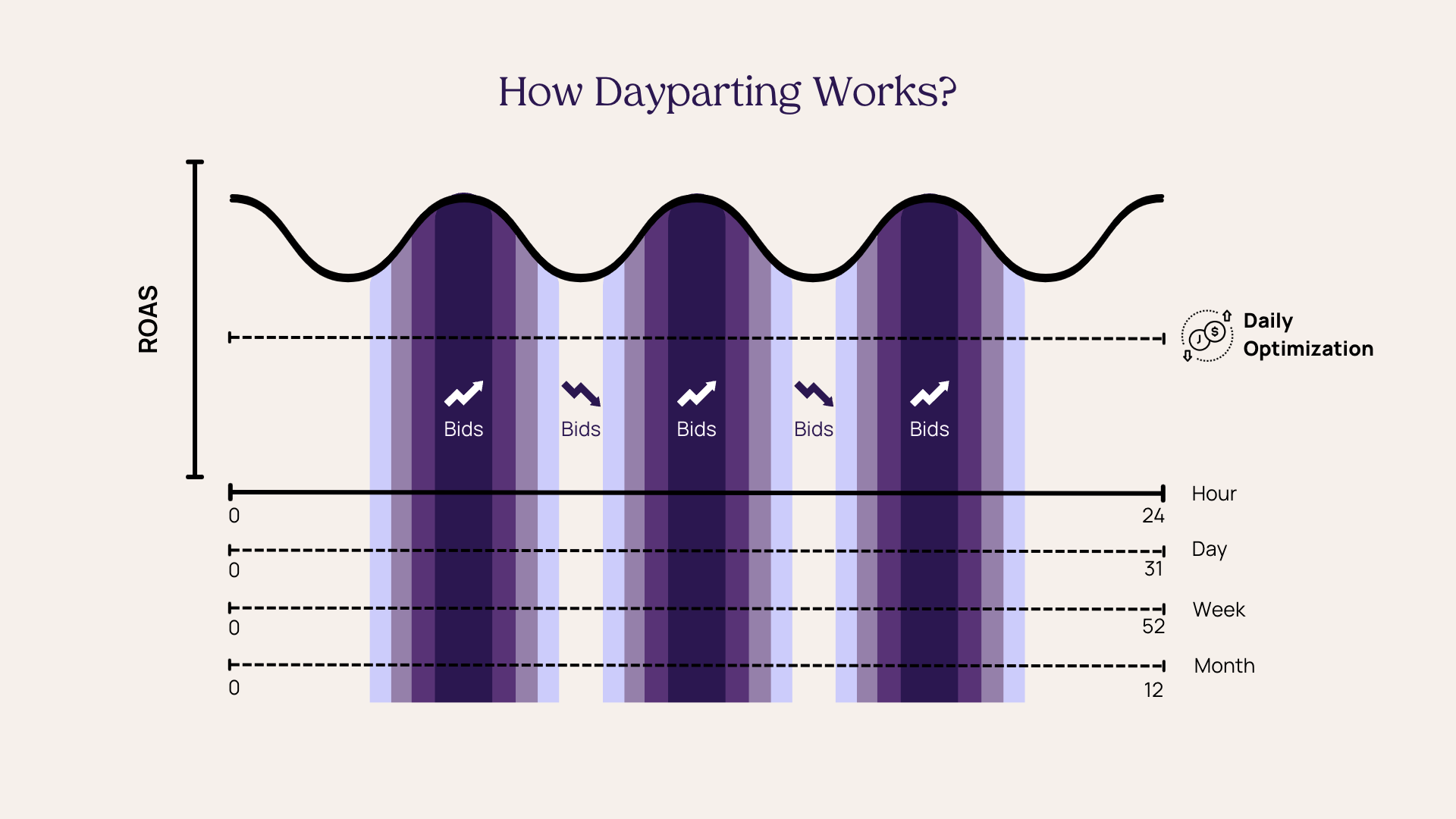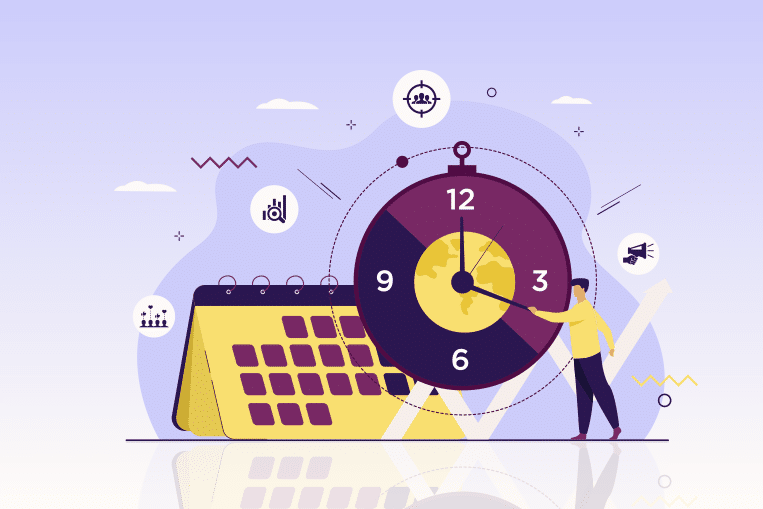Getting the most out of your budget is the most important thing for advertisers. They spend hours researching keywords and optimizing campaigns to achieve the lowest Cost Per Acquisition (CPA).
Lately, achieving goals through Amazon PPC has become more challenging as more sellers are joining and more dollars are spent on Amazon Ads. As a workaround, advertisers are constantly looking for innovative strategies to increase profit margins and remain competitive through Amazon PPC.
One of those ways is dayparting. This is where ad campaigns bid more during times when shoppers are most likely to buy. This potentially leads to conversions with fewer clicks. While sellers have had some success through dayparting, there are some issues with dayparting from data collection to its effectiveness. So the question remains: does Amazon PPC dayparting work?
In this blog, we answer the question of if, why, and how you should approach dayparting to achieve your desired goals.
What is Amazon PPC dayparting?
Dayparting is the practice of only bidding, showing, or promoting your ads at certain times of the day, week, or month. The goal is to hit the hours when your customer base is most likely to shop for your products or make a buying decision.
Similar to social media scheduling, Amazon PPC dayparting allows those looking to get the most exposure for their listing during their audience’s most active times of the day.
For eCommerce, dayparting seems logical. Shoppers usually browse at night and are less likely to make a purchase compared to day. A simple action is turning off the ads or lowering the bids at night. By targeting your specific audience’s most likely-to-buy times of the day, you can optimize more clicks into sales.

Benefits of Amazon PPC dayparting
When done correctly, dayparting can significantly boost your ROI. As successful PPC is about targeting efficiently, dayparting offers a different dimension of targeting.
Here are some benefits of dayparting and how this layers into your Amazon advertising strategy:
Better ROI & conversion rate
With dayparting, shoppers are more likely to convert clicks into purchases than those who waste ad spend with non-committal clicks. By only showing your ads at specific, targeted times each day or week, you filter out window shoppers. While you can’t rely on consumer behavior completely, you can identify patterns and use them to ensure you minimize targeting the ones who cost you CPC.
Prioritize your best-selling hours
The main benefit of dayparting is that you can show ads during your best-selling hours. For example, you can only turn on ads during the evening when conversions are high for you. You can even set a high budget or an aggressive bidding strategy during those hours. This can also be applied to specific days, weeks, or shopping seasons.
Avoid high CPC at non-optimal times
High CPC is determined by high-demand times. Certain times of the day and year cost more than others. However, if your research reveals that your specific audience does not shop during some of these high-demand times, you can save a ton of ad spend that would be more effectively allocated elsewhere during low CPC times. For example, if your spend doubles late at night, you can turn off the ads.
Avoid unnecessary competition
The effectiveness of your PPC campaign is also determined by your competition. As Amazon PPC is auction-based, dayparting can help you avoid unnecessary competition by not participating when bids are high and finding the right balance between conversions and click-through rates. For instance, Amazon algorithms may spend earlier in the day, leaving less competition later in the evening. Dayparting helps you understand your audience and the best time to advertise your products.
Deprioritize known downtimes
On the flip side, you can de-prioritize times when sales are low, conserving your PPC budget for times when clicks are more likely to result in a purchase. For example, if you sell TVs, you can turn off the ads or lower the bid in the mornings. This is assuming people are less likely to purchase a TV early in the day.
Deeper insight into your audience
Dayparting is a motivating reason to get to know your audience better and flesh out your buyer personas. If you discover that your audience shops primarily in the early evening on weekdays, early Saturday morning, or in the middle of the night, this gives you more insight into who your audience is and how the routines of their lifestyles relate to shopping patterns.
Limitations of dayparting
As good as it sounds, Amazon PPC dayparting has its limitations regarding data and results efficacy. Here are some things to know:
Overlooking the research stage
Dayparting without research and context can make you spend erratically. For instance, if you only prioritize high-traffic hours, you may not have considered the research phase and end up with more click-throughs only. Amazon shoppers shop when they have some time to make a decision. Usually, they build a shopping cart or wishlist, and then base their buying decision on these bookmarked items later.
Amazon’s non-granular and misattributed data
It should also be noted that Amazon’s seller analytics tools are not always accurate on a granular level. This means that Amazon might, for example, attribute a click on Thursday to a sale on Saturday, even if there were more steps in between. Amazon also only supplies daily data and you will need to dig deep or use your own tools to gather data from an hourly report.
Miss out on all-hour shopping
Not all of your customers will follow a predictable shopping routine. Those with irregular schedules or shopping habits may look for your products at all hours. With dayparting, you can miss these less predictable opportunities for exposure and sales.
Excluding edge-case and off-cycle customers
Lastly, dayparting may exclude reliable but off-cycle and edge-case customers. For example, a small number of customers who work the night shift or whose days off don’t align with the weekend may stop seeing your products advertised.
Dayparting best practices
Between the benefits and limitations, there are best practices that can help you leverage dayparting and get results. It will help you increase ROI and not get caught up in nuances that won’t serve you.
Determine your goal
To get started, you need to understand the goal of your campaign. If you want to reduce ACoS, you can set some dayparting parameters. However, if your goal is to launch a new product, then it may not be a good idea as you want to increase product visibility.
If you have decided to apply dayparting to a particular campaign, you can set some intuitive ad scheduling for various days, weeks, and seasons. For instance, you may turn on ads:
- During weekdays only if most of your sales convert on those days
- After payday or the first week of the month, or
- During the holiday season when people tend to shop more.
Know your product and audience
A dayparting strategy may not be appropriate for a product that is relatively expensive and has a long purchase cycle. If your product has a shorter purchase cycle, you can use impulse behavior. By understanding what sort of product you have whether seasonal, a novel item, or a must-have item, you can make better campaign strategies.
Not all your products will have the same audience. Your running shoes may have a completely different buyer profile than your sports clothing. Sometimes even different colors of products sell better at different times. You may need to build separate campaigns and dayparting strategies for each product and its variations. For example, you sell red running shoes more than others, therefore, you need multiple campaigns to test.
Use A/B testing
Along with testing product variations, you may need to test products at various hours, sometimes in different campaigns. Comparing campaigns for mornings vs evenings, or weekdays vs weekends would be crucial to understanding what times work best.
It may require a lot more testing, which sometimes may not be worth it. Therefore, understanding what products to target for dayparting is also critical. Otherwise, you would spend all that time and not get the result you wanted.
Be aware of high bid times
You may fall into the trap of busy traffic times with high bids costing you a high CPA. It can counteract your goal and may use more of your budget than you anticipate. It can happen during the shopping season when bids are doubled or tripled.
Should you do Amazon dayparting?
If you have the right dayparting strategy and follow best practices, you can increase your profit margins. But doing it manually may take time and inaccurate interpretation. One of the most effective ways to use dayparting is through automation tools.
Dayparting requires intense data analysis which may not be worth it if you test it improperly. But if you use tools designed for dayparting, you can see significant results, which could become a part of your strategy. While Amazon’s hourly data has limitations, there are tools to help you mitigate its flaws.
Trellis’ eCommerce advertising and merchandising platform has dayparting configured in its advertising algorithms. Trellis analyzes days, weeks, and shopping seasons to identify the most performing periods for ads. To learn more about dayparting with Trellis, book a demo with our experts!



